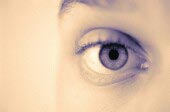By Serena Gordon
HealthDay Reporter

Tuesday, Feb. 19 (HealthDay News) -- The eyes may not just be a window to the soul, they may also provide a clear view to the state of your other senses.
A new study reports that the eyes can provide clues that tell researchers how well a person can hear. This finding may be especially helpful for diagnosing hearing problems in babies, very young children and in people who can't actively take a hearing test, such as those with a traumatic brain injury.
"When most animals detect a change in their environment, their pupils dilate. And, the quieter the sound, the less the dilation," explained study author Avinash Bala, a research associate at the University of Oregon in Eugene. "One of the things you can use this for is to see when a sound becomes detectable."
About 28 million Americans have some degree of hearing loss, according to the National Institute on Deafness and Other Communication Disorders. Approximately two to three out of every 1,000 children are born deaf or hard-of-hearing. Because hearing is so critical to speech and language development, experts believe that the sooner a hearing problem is diagnosed in babies and young children, the better.
However, detecting hearing problems in infants and young children can be difficult, because they can't respond to normal hearing tests as older children and adults do.
When Bala was working with barn owls, he realized that their pupils dilate in response to sound, and that the pupils responded in proportion to the volume of the sound. Bala said this is called an "orienting reflex response."
"Whenever there is a change in our environment, the natural reaction is to turn and look at it," he explained. At the same time, the heart rate slows, breathing slows, and the pupils dilate to allow the ability to assess the threat of the change. If the sound is repeated numerous times, and there's no threat detected, animals and humans quickly learn to ignore such sounds, according to Bala. This is known as habituating.
Bala and his colleagues thought they might be able to use this pupillary dilation response (PDR) to measure a person's ability to hear.
To test this theory, they recruited 22 healthy volunteers and asked them to listen to a variety of noises. While they were listening to the sounds, their eye movements were tracked by a camera. In this study, the subject kept their heads still by placing their chin in a chin rest, but Bala said that if a camera were mounted far enough away from the subject, they wouldn't need to be still. Or, he said, it's possible that they could use a pair of specialized goggles to detect changes in pupil size.
They found that when a novel sound was introduced, the pupils in human eyes dilated, and if the sound was repeated numerous times, the volunteers quickly became habituated to the sound. To counter this habituation, the researchers varied the sounds.
For 11 of the study participants, the researchers also asked when they heard a certain noise and compared those results to those obtained by the pupil response, and found that the results were very similar, within three decibels.
Results of the study were to be presented Tuesday at the Association for Research in Otolaryngology meeting in Phoenix.
Diane Sabo, director of the division of audiology and communication disorders at Children's Hospital of Pittsburgh, said the findings were "intriguing" and that a three-decibel difference was very small.
"Any time you work with babies and young children, you're always looking for a physiological response, because they can't tell you anything," she said. She did express concern that in this study, the participants kept their head still, because that's something that definitely won't happen with babies and young children.
"This sounds really interesting, but whether it can translate into a useful clinical tool is probably a long way off," said Sabo.
More information
Read this information from the Nemours Foundation to learn the signs to watch for that might indicate your baby has a hearing problem.
Taken from: www.healthday.com.

